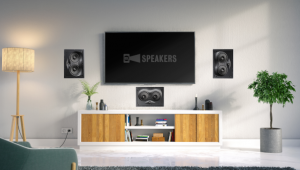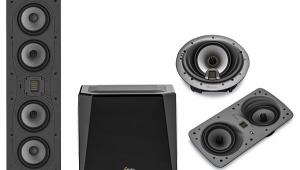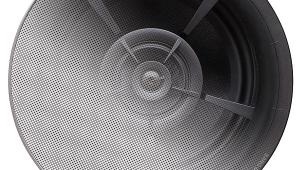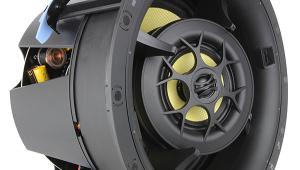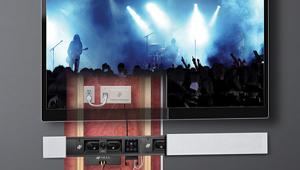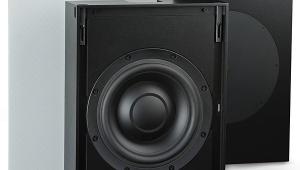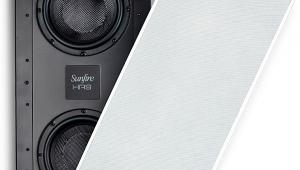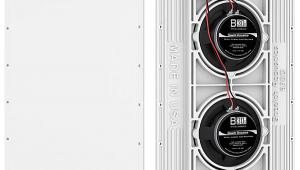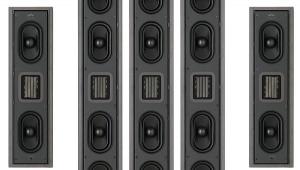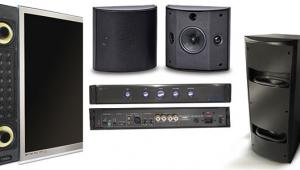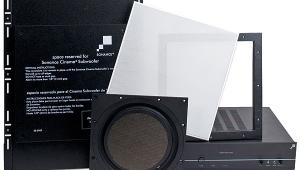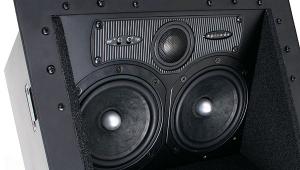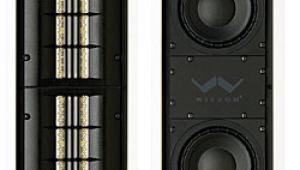Wisdom Audio Sage L100i In-Wall Speaker System Page 2
SCS Suitcase Subwoofer
It’s reasonable to assume that 40 woofers in a five-channel system would be adequate—but that would be incorrect. The 40 woofers are effective down to about 40 Hz, but below that, the Wisdom Audio Suitcase Sub (SCS) takes over. The SCS, so named for its form, is a freestanding design that resembles a large suitcase. You can presumably hide it behind or beneath furnishings. The SCS is what Wisdom calls a Regenerative Transmission Line enclosure, a modified transmission line and a form of labyrinth enclosure. For flexible placement, you can direct the SCS’ output to the front, rear, or side of the subwoofer cabinet. The SCS uses dual 5-by-7.5-inch drivers powered by a built-in amp rated at 400 watts.

SC-1 System Controller and Amplifiers
The SC-1 System Controller is the heart and brains of this system. It’s an active crossover between the woofers, the planar magnetic drivers, and the subwoofer. It also provides system-specific equalization curves and is configured for each installation using the Audyssey MultEQ XT room-correction system for all channels. The Audyssey MultEQ XT system uses the Audyssey Pro PC-based application to measure and then equalize the system for the listening room. It uses a more sophisticated and carefully calibrated microphone than the one that ships with typical Audyssey-equipped AVRs and surround processors. The SC-1 has four selectable equalization curves, each with slightly different sound characteristics for various programs and listening preferences. You can also tweak each curve to create custom EQ settings.
Since the planar magnetic drivers and bass arrays must be amplified separately, a fivechannel system requires ten channels of amplification. I used seven amplifiers in this system, a combination of Wisdom Audio SA-1, SA-2, and SA-3 power amplifiers (dual mono-single input, two, and three channels, respectively). Each has 500 watts per channel, for a total of 6,000 watts of power. I rack-mounted the amps and the SC-1 System Controller in a refrigerator-sized equipment rack.
You can use any suitably powered amplifier to drive the Sage Series speakers, so you don’t need to ditch your favorite amp. Wisdom Audio doesn’t specify minimum power requirements, but the L100i and C150i have a relatively high claimed sensitivity of 95 decibels, including the statement that they can handle more than 1,000 watts of peak power each.
In addition to the amps and the SC-1 System Controller, the system requires a surround processor with balanced line outputs and interconnects, which I used throughout the system. I used Anthem’s highly regarded AVM 50v.
Some Assembly and Installation Required, Professional Supervision Recommended
As with any in-wall speaker, a solid wall will help the L100i and C150i perform their best. While these speakers fit in standard 2-by-4 walls, they also come with integrated, airtight back boxes that are made from ribbed, extruded aluminum. Moreover, the Uni-Grip mounting system clamps the drywall along the entire length of the speaker, instead of just at a few discrete points like dogleg clamps. Wisdom Audio requires that its systems be installed and calibrated by authorized, trained dealers to ensure that you get optimal results. You should solicit their advice on whether your walls are already sufficiently solid or could use some reinforcement.
I want to communicate the true size and scope of this system and the room needed to install it. I use a 104-inch-diagonal smX CineWeave acoustically transparent projection screen, and it wasn’t wide enough that I could place the left, center, and right speakers behind it with adequate stereo separation. So the L100i speakers flanked the screen.
For the record, I didn’t rebuild my living room to review this system, although the 948 pounds of speakers and gear made it feel that way. Wisdom Audio provided floorstanding enclosures for the L100i and C150i speakers (like the enclosures described above). I placed these directly against the wall and secured them to a stud using a bracket to keep them from falling. Within a review setting, this is as close to a true in-wall installation as was possible.
The Disappearing Speaker
Audiophiles think very deeply about a speaker’s acoustic personality and use an overabundance of highbrow terms to describe sound quality. Audiophile jargon is subjective, but it expresses what the listener hears. A speaker may sound lively or laid-back, rich and full, or thin and lifeless. Accurate and uncolored are also common terms, but reviewers almost never use them correctly. I’ve settled on invisible to describe the Wisdom Audio Sage speaker system, a term that describes listening through the speakers (and the screen) and directly to the musician or performer. While some speakers are in your face and others are more reserved, the Sage speaker system simply disappears, revealing extraordinary aliveness, involvement, and realism. It’s like being there.
- Log in or register to post comments
